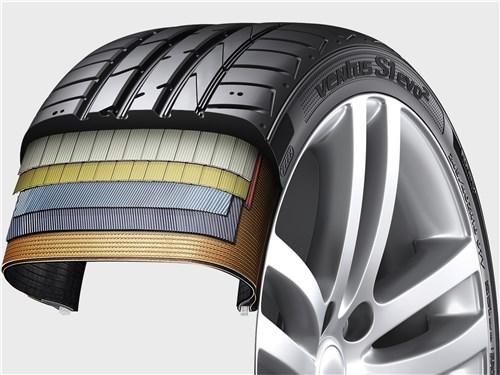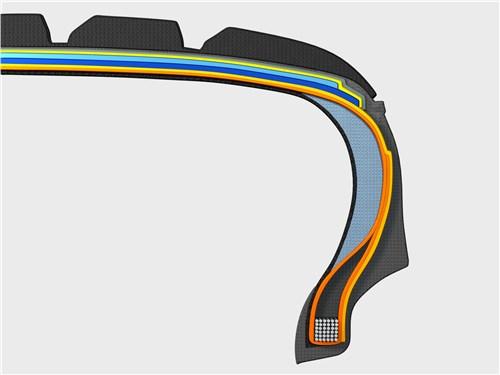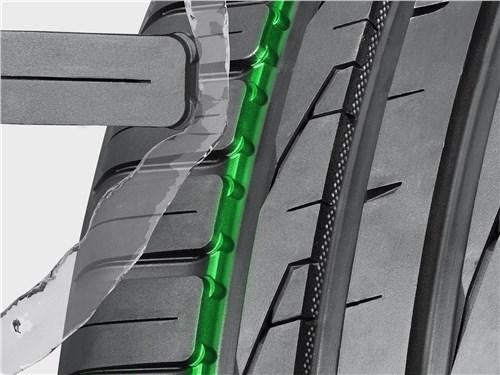Tires and rims: unlike… Gemini
The combination of this UHP tire steel belt and rayon carcass helps keep the contact patch under extreme loads
The twisted wire belt not only maintains the shape of the tire when maneuvering at high speed, but also retains its strength on poor asphalt.
Even the intricate tread pattern and high-tech rubber compound cannot function without a complex multi-layered frame.
To combat hydroplaning, complex physical phenomena are sometimes used, for example, the Coanda effect.
Passenger summer tires in most cases do not differ in the variety and complexity of the pattern, like winter models. But each element of the tread hides many complex technical solutions behind the external simplicity, no less than the engineering know-how contained in the rubber compound and carcass design. Tell how they can affect the purchase
Every year, before the next seasonal tire change, we massively ask one question: will there be good tires from a well-known Japanese (French, Italian, German, Scandinavian, Korean) manufacturer? And we are again forced to answer that the "diagnosis" only by the name of the brand is almost impossible. Let’s start with the fact that even premium brands have expensive and more affordable models with different balances of performance between "excellent" and "good". Other companies can afford to have both these masterpieces and frankly mediocre samples in the model line. And, most importantly, you need to choose not a manufacturer, but a specific tire model, depending on the size, purpose, driving style, road and weather conditions and vehicle features.
The division of summer tires into separate classes of high-speed (HP) and ultra-high performance (UHP), touring, urban, environmental and other models, as well as the gradation of "sport", "Comfort", "Sport + comfort", etc., today is common and can be sent to the buyer at the first stage of selection. Yes, and the height of the bar for the requirements of the company is often selected in their own way. As the results of numerous tests show, and sometimes other premium station wagons, a workhorse can beat in speed and handling "sports" tires not a particularly ambitious producer.
By the way, speed does not indicate the quality of sports summer tires. If one model with the cherished letter Y (300 km / h) in order to flawlessly cut turns on the highway, then another of the same index may mean that it does not collapse in a straight line if the driver suddenly squeezes the throttle to this limit. In fact, this refers to the strength characteristics of the tire, which are usually planned with a fair margin.
In order not to get lost in the choice, first of all take care of the tires selection of a car according to purely technical parameters. As a rule, recommendations such as on the websites of tire manufacturers and automakers. And here you can choose several options for the best price-quality ratio and behavior on the road, the results in tests and reviews.
Jogging and water procedures
The first impression of the bus we get from the tread pattern. However, in recent years most summer tires don’t look alike, like twins, due to an overall asymmetrical design that visually aligns tires of different categories and prices. Another thing is symmetrical models, gradually moving into a separate niche for driving enthusiasts and the emergence of individuality. In some cases (Toyo Proxes T1R or Yokohama AD08R ca. Yes) deliberately effective, and even pragmatic Koreans prefer to call it a very fast and stable Hankook Ventus B12 Evo2 tire "for drivers who attach importance to their own style", as if putting it higher performance design.
Focusing only on the tread pattern is definitely not worth it, unless you pick up an exhibition tire so, although it may give some clues. Theoretically, ceteris paribus, asymmetric tires should demonstrate an advantage in most road disciplines: acceleration, braking, handling, cornering stability due to the specialization of different tread zones. As a rule, this is the outer part, made more rigid due to large rounded blocks that reach the knees and the inner zone contains additional connecting elements and is responsible for handling and directional stability.
The symmetrical directional tread pattern of summer tires is often referred to as a "rain" pattern. Indeed, the slanting swept channels, especially, expand, moving slightly compressed and very quickly removing water from the rubber douche. But it all depends on the segment and purpose of the tire, and asymmetrical models also have an effective technology for evacuating water. And this is not trivial and requires three or four wide longitudinal channels – for example, Nokian, these channels are equipped with smooth polished walls, so that the water does not encounter the slightest obstacle in its path. Due to the specifics of the Scandinavian climate, the manufacturer basically pays "drain" a lot of attention, often using non-standard solutions, like ledges on blocks, creates a Coanda effect when, due to pressure drop, liquids seem to stick to one of the walls and evacuate in a given direction. Increasingly, manufacturers are using other hydrodynamic elements in the channels in the form of protrusions or recesses that have a special shape that helps to “disperse" water and throw it out of the contact patch. So in a battle with a water film on the road, this is a clear leader among all types of defender has not yet been determined.
But their main properties of the tread elements of a car’s summer tires must be demonstrated on a durable dry surface, and then it turns out that seemingly similar models have a lot of their secrets. Technical solutions that are designed to keep the shape of the tread blocks in case of overload. So, their edges are made beveled or rounded, so they do not hide under the tread when braking (especially in the Michelin family, primacy). Sometimes manufacturers use the opposite effect when tread deflection is a good thing – for example, Goodyear’s active braking technology expands the blocks under braking, increasing the grip surface.
Block pitch also matters. On the one hand, the important cross-connection of the edges, which improve grip, especially on wet surfaces. On the other hand, manufacturers are trying to make the tread smoother, more likely to use solid elements (like solid longitudinal ribs), as rolling resistance decreases, the fewer joints reduce acoustic resonance in road bumps. And here the experience and skill of the developers depend on the balance of sometimes opposite characteristics that allow the tire to work equally effectively in different road and weather conditions.
Even not very noticeable nuances in the tread pattern can change the characteristics and behavior of tires. It illustrates the latest generation Pirelli PZero UHP tire, which is offered in three versions: for powerful luxury sedans, sports cars and true supercars. The sportier and faster the changes, the larger and denser the blocks of the shoulder zones, wide longitudinal ribs, small joints, and the “cutting” of the tread are the transverse grooves. Of course, all this only works in combination with an individual rubber compound and internal skeleton.
Bending and leaning
The rubber compound is a gray cardinal (or rather, black) that behind the facade of the external appearance, the bus finally makes a verdict on how the wheel will behave on the road. It is not surprising that the attempts of some, to put it mildly, incomprehensible and unscrupulous firms to clone successful models from well-known manufacturers are divided into exact rubber formulations, although the similarities are obvious.
It is, as always, especially balance. The softer the rubber, the better it sticks to the bumps in the road, providing good grip even on wet surfaces, but it also tends to fade quickly, like an eraser, in particular when hot. Hard rubber is also beneficial – less rolling resistance and, therefore, reduces the load on the engine and saves fuel, but at the same time it does not wear out as quickly.
The rubber compound recipe is one of the most important know-how of the manufacturer, the secret of which is kept under seven seals, and a wide range of users (and sellers) need to know that the new rubber (once again) involves "high silica content and elastomery" that improve distribution of the notorious silicon dioxide in the mixture. And so, conjuring over chemical elements and molecular bonds, the developers are trying to make sure that the rubber "sticks" to the asphalt, but does not leave small particles, after the float, elastically reacts to road bumps, but does not walk like jelly, under rapidly changing loads. And there, if necessary, it is already possible to shift the balance in the right direction: at least, make a “sticky” racing slick, whose life is several races, although, as they like in the south of the Asian village,
Rich inner world
Many important technologies are hidden from view and are literally inside the tire – we are talking about the Frame and other elements of internal structures that must not only determine the shape, but also to maintain the stability of the contact patch (and therefore compression) under various load conditions, so as not to allow accessories to stretch and deform under the action of centrifugal force and ensure mechanical strength, resistance to punctures, cuts and impacts is possible.
Creative thinking must be the developers of high-speed tires, which are constantly subjected to exorbitant stress. As part of the Nokian Hakka Black, still the first generation, was buried 2.5 km from a very thin steel wire twisted into three wires, which significantly increased the tire’s durability even on bad roads. And the creators of the successful model Michelin Pilot Sport 4-x bet on a hybrid aramid-nylon breaker, which, according to them, is five times stronger than steel at break and thus does not increase the weight of the car, so the tire works well not only on the roads, but also on race tracks.
Almost all modern car tires have a radial design where the threads of the frame are perpendicular to the direction of motion, this helps the tire to keep its normal appearance to keep the contact patch and less wear. The diagonal design, where the strands overlap at an angle to each other, is much worse than running on a hard surface and at high speed, and therefore in the past, although sometimes found in models for extreme off-road special equipment (due to the reinforced sidewall). But in Japanese Yokohama, they suddenly decided to combine the advantages of each design and, created for the Model Advan Sport V105, a hybrid carcass, which, along with the radial overlap of the threads in the central tread area, is diagonal and located in the shoulder area on the sides. This matrix body layer allows the tire to maintain contact stability in case of overload in curves. The recognized authority in the world of sports tires Pirelli in the development of the latest generation of the PZero series has solved the same problem by creating tires for Formula 1 racing. The F1-ball technology uses a particularly hard rubber compound in the sidewall area, which keeps the tires from deforming laterally.
Manufacturers focused on the mass budget segment should also pay attention to the frame. For example, the city’s brand new Radial FE1 GT from Asian giant Giti tires uses a fully synthetic and therefore lightweight carcass to reduce unsprung weight. Given that the tire is positioned as a "daily use" model, it is very useful in order to increase durability and efficiency.
It is important to add that all the properties of tires declared by the manufacturer can appear only with their proper use. What’s the point of choosing environmentally friendly models with low rolling resistance and good wear resistance if you do not maintain the correct level of pressure in the wheel? Or expect tire wear to be managed and brake like new just because of brand magic? Here we will answer another common question about whether to buy used tires: top models often wear new "middle peasants", not to mention possible hidden frame defects. But the choice of new rubber in the current market is very wide.



